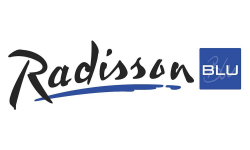The Client
The Radisson Blu Hotel, Leeds City Centre is set in a meticulously restored building that once served as the main office of the Leeds Permanent Building Society. This grand building has preserved its original art deco style.
The Radisson Blu Hotel, Leeds City Centre features 147 rooms for business or leisure travellers, complete with free Wi-Fi and in-room coffee and tea facilities. Ten versatile, 70-delegate capacity meeting rooms located over two purpose-designed conference floors.
Radisson Leeds is part of Radisson Hotel Group one of the fastest growing global hotel operators with an ambitious Net Zero target for all its properties.


The Brief
SaveMoneyCutCarbon has a long-standing relationship with Radisson Hotel Group, and originally retrofitted LED lighting 7 years ago at this property. Many of the luminaires have been on 24/7 since installation in key areas like corridors and guest areas but these luminaires, having delivered material savings, were now coming to end-of-life with reduced light output and render changes.
The challenge was how to demonstrate further savings and payback to trigger the necessary sustainability funding when effectively all that could be done was to replace end-of-life luminaires with new LED.
LED luminaire performance has improved since 2016, which means that comparable light outputs can be achieved with even lower wattage – the original LEDs were 7W and the new equivalents are 3.9W. But savings and payback were nowhere close to the payback of the original halogen-to-LED. swap out.
One option was to control smaller groups of luminaires in more focused areas but the challenge here would involve considerable new wiring to create many new individually controllable circuits, which would cause major disturbance and high costs, with prohibitive payback times.
Vicky Moors, Hospitality Lead & Major Account manager at SaveMoneyCutCarbon was given the task to find a cost-effective solution by Simon Pearson, Area Chief Engineer, UK and Ireland at Radisson Hotel Group.
The Solution
Utilising the experts in the Demand Reduction Tech hub at SaveMoneyCutCarbon, who are continually testing new solutions to reduce energy consumption for their clients, the solution was to move control to each and every luminaire from the smallest GU10 through to tubes and panels.
Having the controls inside the luminaire, not in the circuit, means that individual luminaires can be grouped where needed and wireless-linked to occupancy and daylight sensors – without the need for new wiring.
The result is a fully controllable lighting solution down to individual luminaire level but installed in 80% less time, less disturbance and lower cost than traditional or circuit-level wireless controls.
With controls at individual luminaire level, small groups of lights can be set to adjust to daylight, while remaining at very low idle levels, providing good ambient lighting, with brighter light at set periods of time as guest and staff move around the hotel.
After detailed audit and investment grade proposal, the SaveMoneyCutCarbon team installed circa 600 replacement lamps and luminaires and associated wireless sensors, working closely with hotel management to minimise disruption.
Existing end of life 2700k LED bulbs (7W) in all the guest corridors were switched to 3000k (3.9W) dimmable Interact Pro bulbs, set to dim to 25% after 5 minutes with no activity group in small groups of lamps in small zones.
Dale Richardson, SaveMoneyCutCarbon Project Manager, explains: “This approach dramatically reduced the disruption for the hotel. My team just changed the lamp or luminaire, mounted the sensors in each zone, configured from the engineer’s app and it was up and running.”
Through this control methodology, on average the new GU10 are idling at under 1W for the majority of the day when guest and staff are not present in each zone. The result is a material saving of on average 81.4% from the original 7W LEDs, delivering a viable payback to support the hotel’s Net Zero funding & ROI criteria.
Savings Summary
-
£10,739
£ saved
-
81.4%
tonnes
-
42,973 kWh
kWh
-
3.4
years payback